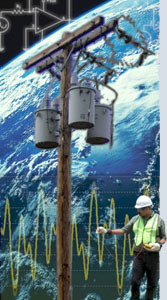Overview
Background
Complaints related to contact voltage for pedestrians and animals have long been an area of concern and subjective interpretation for utilities, regulators, and the public.
- Humans and animals have experienced electric shock in urban areas when they contact objects that contain or are nearby faulted electrified wiring.
- Humans occasionally complain of perceptible tingling sensations while swimming in pools that have inadequate or degraded equipotential bonding connections.
- Dairy farms must be designed with electrical standards that provide reasonable confidence that animals are not exposed to voltages above their perception levels.
- Public marinas and other areas with electrical service extending into bodies of water commonly post warning signs to discourage or disallow swimming in such locations.
- Fences, light poles, and metallic pipelines can become electrically charged from nearby overhead power lines.
While not all of these conditions are lethal or detrimental to health or safety, it is better to err on side of caution and avoidance (when encountering a possible shock scenario) until trained or certified personnel can determine the cause and relative risk of such scenarios. If any of these situations or similar situations are encountered and you are not sure about the source of the shocking, it is advisable to take necessary steps to keep humans and animals away from the area of concern (best handled by calling local authorities for publicly accessible locations) and additionally contacting the local electric service provider so that they can assess the situation.
Research Summary
Since the mid-1980s, EPRI has been assessing electric shock concerns related to work environments, publicly accessible locations, and animal confinement areas. The work began by understanding elevated voltage potentials on gas pipelines, then moved to publications and comparisons of animal sensitivities to stray voltage. The most recent focus has expanded to shocks and perception complaints at swimming pools and shock complaints and detection methods in public and pedestrian thoroughfares. This work has been coordinated with an IEEE working group to help in the creation IEEE 1695-2016, Guide to Understanding, Diagnosing, and Mitigating Stray and Contact Voltage.
Each year, EPRI research considers the most important concerns associated with stray and contact voltages at human and animal contact points by promoting consistent and repeatable assessment methodologies, sponsoring workshops, and creating a repository of case studies and general information. These and other project efforts are geared toward expediting problem identification and resolution.
The project results are distilled on this website to promote the widespread dissemination of research results where that information benefits affected parties. The areas where this website provides that information include:
- Measurement equipment and protocols
- Mitigation techniques and devices
- Modeling and simulation approaches
- Impacts on humans and animals
- Approaches for understanding limits and levels of concern
- Links to relevant industry information
- Select case studies
EPRI very much appreciates the electric utilities that sponsored this research and the organizations that have conducted credible human and animal bioelectric research in contribution to the industry’s understanding of the subject matter.

